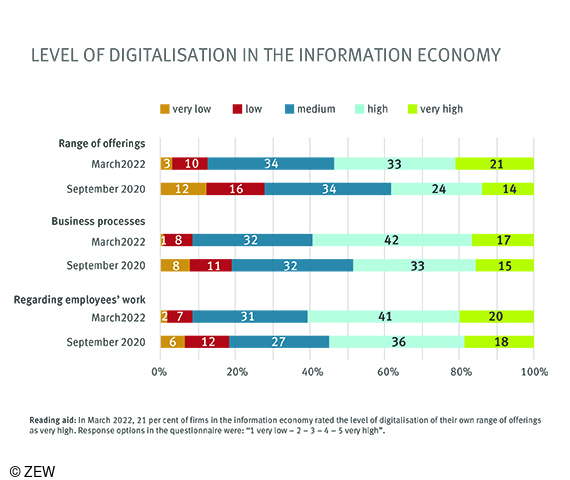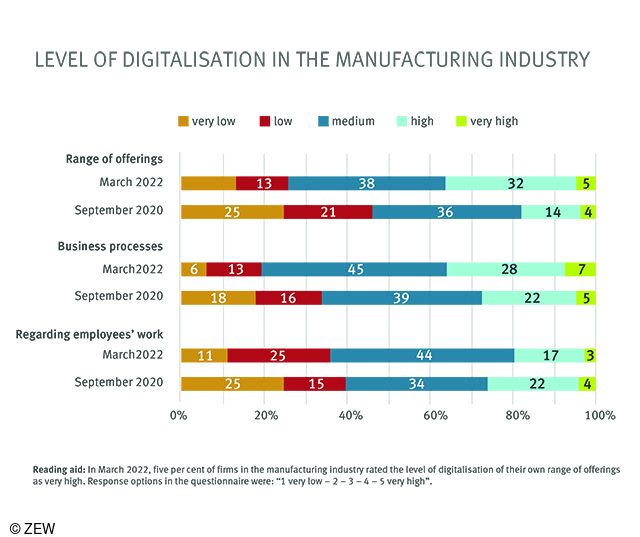Firms Made Progress in Digitalisation During COVID-19 Pandemic
Information EconomyWhen it comes to digitalisation, many firms in Germany have made quite some progress in the course of the COVID-19 pandemic. In March 2022, for example, 54 per cent of firms in the information economy rated the level of digitalisation of their own products and services as high or very high, while this figure was still 38 per cent in September 2020. Meanwhile, in the manufacturing industry, the share of firms with a high or very high level of digitalisation of products and services has risen from 18 per cent in September 2020 to 37 per cent in March 2022.
In addition, firms were also asked about the level of digitalisation of their business processes as well as of their employees’ working environment. To assess their own level of digitalisation, the firms could choose between five categories ranging from “very low” to “very high”. In the same way, the firms had already been surveyed in September 2020 regarding the level of digitalisation of their range of products and services, business processes and their employees’ working environment. By comparing the results, it is possible to determine the progress of digitalisation in individual sectors.
“In the information economy, as well as in the manufacturing sector, the share of firms with a high or very high level of digitalisation has risen significantly within the last two years,” says Dr. Daniel Erdsiek, a researcher in ZEW’s “Digital Economy” Department. The only exception is the working environment of employees in the manufacturing sector, which was rated as high or very high by 26 per cent of firms in September 2020, compared to 20 per cent in March 2022. However, in other areas, digitalisation has progressed. “The boost in digitalisation is most noticeable in the range of products and services. In March 2022, 54 per cent of firms in the information economy and 37 per cent of firms in the manufacturing sector rated the level of digitalisation of their own products and services as high or very high. Two years ago, these figures were at 38 and 18 per cent, respectively,” says Erdsiek. The digitalisation of their own business processes is estimated as high or very high by 59 per cent of firms in the information economy and 35 per cent in the manufacturing sector. Six months into the COVID-19 pandemic, these figures were at 48 and 27 per cent.
Fewer firms have a very low level of digitalisation
Overall, the results show that today fewer firms rate their own level of digitalisation as low or very low than at the start of the pandemic. Especially the number of firms with a very low level of digitalisation is declining. In the information economy, the percentage of firms with a very low level of digitalisation in their range of products and services has fallen from twelve per cent to three per cent. In business processes, this percentage dropped from eight to one per cent, and from six to two per cent in employees’ working environment. In the manufacturing sector, the number of firms with a very low level of digitalisation declined by approximately twelve percentage points across the three categories. The share of firms with a low level of digitalisation of their range of products and services fell by six percentage points in the information economy and by eight percentage points in the manufacturing sector. In conclusion, according to their own assessment, firms in the information economy and in the manufacturing sector have made considerable progress in the digitalisation of various business areas since autumn 2020.


